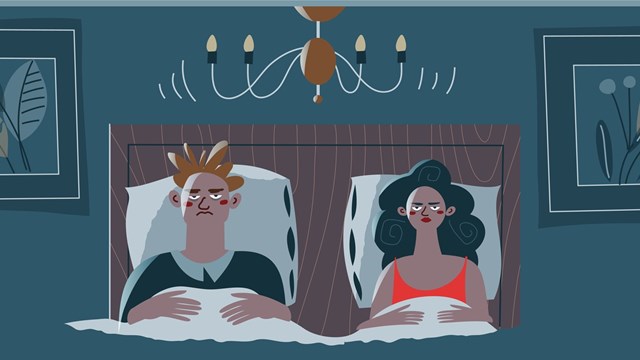Depending on our profession and habits, we may interact with dozens of people on any given day. And amidst all of these interactions, we inevitably experience annoyances: being squashed among fellow commuters on the train; scoffing at the dude ‘man-spreading’ across three seats; standing in line at the grocery store and clearing our throat at the lady who is quibbling about a 25-cent coupon; and avoiding the annoying coworker with terrible breath who always wants to talk endlessly about his boring weekend plans. We air our grievances by complaining to friends over drinks or texting the angry-face emoji to our significant others. We blow off steam and we get over it.
But what if the issue isn’t on the train or at CVS, but at home? And what if it’s not momentary, but continuous? Our homes are the sanctuaries between four walls where we escape the crowded trains and frustrating work environments. So when the gripes and grumbles are where we dwell and decompress, it’s harder to just shake it off. Sometimes, a minor gripe between two condo or co-op residents – or between a resident and their board – can metamorphose into something much more serious, and expensive. Once the scales start tipping toward lawyers and litigation, it may be time to step back, take a breath, and try to get things back on more amicable footing. One way to do that is with what’s commonly referred to as alternative dispute resolution, or ADR.
Nobody Likes a Lawsuit
Lawsuits are expensive, acrimonious undertakings that can erode both the finances and the morale of building communities, but luckily there are alternatives to knockdown, drag-out litigation. Mediation and arbitration can resolve conflicts without involving courts, and can be a cheaper, friendlier way to restore peace to the microcosm that is a cooperative or condo building. As the New York City Bar’s co-op and condo residential dispute guide suggests, “Mediate, don’t litigate!”
Scott B. Piekarsky, Esq., managing member at Piekarsky & Associates, LLC in Wyckoff, New Jersey, agrees and explains that the most common points of conflict between residents and condo boards typically deal with everyday things like noise levels, pet-related concerns, parking area violations, and non-payment or lateness of fees. If a resident’s assessment bills aren’t being paid on time, or they insist on blasting the Rolling Stones at 6 a.m. every Saturday, and a late notice or simple, ‘Hey neighbor, can you turn your music down?’ isn’t solving the problem--then action may need to be taken to maintain quality of life and keep the building happy and healthy. However, if such an issue escalates into a serious dispute and the threat of litigation is brought into the mix, it can make a bad situation worse.
If there is a problem in a building, and the usual protocols of late notices (in the case of arrearages), cease-and-desist letters (in the case of noise complaints) or general notices to remind residents of their community rules and regulations aren’t improving the situation – or if communication and civility between residents and the board has broken down – a professional mediator can be introduced before there is even a whiff of lawyers or courtrooms. But how to know when it’s time to bring a mediator in, and who should make that call? A resident embroiled in a nasty spat with a neighbor may or may not have the wherewithal to calmly call upon a mediator, so in many cases it is the property manager who receives complaints and then sends out the bat signal for a mediator.
As Ronald J. Gold, a partner at the law firm of Kagan Lubic Lepper Finkelstein & Gold, LLP in New York, explains that while it’s not the property manager’s responsibility to police residents, it is his or her responsibility to look into the complaint or issue and then make an initial decision: should the building get involved or not? Can they suggest a mediator? If there is the potential for real damage or violation of a lease or building bylaws, the manager must act, and ADR can be an inexpensive and more peaceful solution than having all the parties involved get lawyered up and start filing suit against each other. Involving a mediator can also keep the management out of the situation, preserving their neutrality and keeping appropriate boundaries in place, though as Piekarsky notes, “Managers are often liaison to a building board, and/or witness at the mediation or arbitration.”
Next Steps
Depending on your location, the first step to side-stepping litigation and working through the ADR process is find a reputable source to do the job right. For instance, the New York City Bar Association has a department of well-trained mediators who deal specifically with condominium and co-op complaints. But, as Gold warns, “Of course, the [disputing] parties have to be willing to go through the process.”
The New York City Bar guide explains the mediation process as “a fairly informal, usually voluntary approach to settling disputes instead of going to court or having a co-op or condo board impose a decision. A neutral person – a trained mediator – facilitates negotiations between parties to help them find a mutually acceptable resolution to their issues. Mediation is confidential and non-binding; either party or the mediator may stop the process at any time. If the parties do reach a resolution, a settlement agreement will be signed and is binding on both parties.”
Piekarsky explains the difference between mediation and arbitration, “Mediation is like a settlement conference where possible solutions are suggested for adoption and settlement, but are not binding if not everyone is willing to accept them. Arbitration is like a mini, informal hearing by one or more individuals that then results in a binding decision.” Piekarsky notes that in some states, including New Jersey, an arbitration decision in a condominium setting can be challenged later in court.
If you’re at the point of mediation or arbitration, there is likely a certain level of tension between the parties involved, and a professional mediator or arbitrator is trained to create space for negotiation and solutions, despite the rancor and hostility that got them involved in the first place. As Gold explains, “A mediator facilities a conversation between the parties, to find common ground and create a sort of contract where they both agree to do whatever they decide. That is the mediator’s duty.”
The New York City Bar guide on mediation notes that, “The parties to the mediation are advised that the mediator is NOT representing either party, and that no attorney-client relationship or privilege exists between the mediator and the parties. Although he or she is an attorney, the mediator is not providing legal services to the parties, but is acting as an independent, neutral facilitator to the disputants in order to assist them in resolving their own dispute.”
While it depends on the situation and personalities involved that make every conflict unique, mediation often involves bringing the parties together (though perhaps in separate rooms) and having the mediator conference back and forth between them, hearing from party one, then sitting down with party two, transmitting messages – neutrally – between the two until a mutually acceptable compromise can be met. Gold explains that the exact steps of mediation depend on the basic facts of each dispute. For instance, with a noise complaint issue, “One man’s thumping is another man’s tippy toes, and everyone thinks they are right,” so trained mediators are in the position to objectively understand and broker a solution between the parties.
Piekarsky adds that pre-mediation, “Parties often submit confidential position papers for the mediator. If an agreement can be reached, it’s put in writing and signed by all parties to insure enforceability later.”
Putting things in writing is vital. Documents – like a building’s bylaws, or the terms of a resident’s lease – dictate the rules and regulations that residents must adhere to, and can be used to facilitate mediation, as they usually spell out who is responsible for what. If mediation takes place, Piekarsky notes “Both sides can agree to bind themselves to a final resolution. A signed written agreement is imperative.”
Happy Ending?
The New York City Bar guide explains that a successful mediation may end “by the parties signing a settlement agreement; by a statement by the mediator that further efforts at mediation are not worthwhile at this time; or by a statement by a party that they choose to terminate the mediation prior to settlement.”
If talking it out doesn’t end with a big group hug, Gold points out that the next steps depend on the severity of the situation, and the attitude of the parties involved. “Arbitration, suing, litigation. One party sues the other, claiming that they should be stopped from doing something or they think the building has an obligation.”
And, as the Bar guide notes, the mediation process is private: “All documents and verbal information disclosed to a mediator during the course of mediation under these Procedures shall be deemed confidential and private and shall not be divulged by the mediator to the other party unless the relevant party authorizes disclosure, or to any third party except as required by law and in response to a court order. In case of any subsequent proceeding, the mediator may not be subpoenaed by either party to furnish documents presented during mediation, nor to reveal the nature or content of any information discussed or revealed during mediation. Further to that end, the mediator shall not keep any documents or any copies thereof presented during the course of mediation.”
Of course, while ADR can save money – by some estimates, it’s 85 percent cheaper than a lawsuit – it’s not free. Depending on the region, the experience of the mediator, the time it takes to deal with the conflict, and the nature of the conflict itself, a mediator might charge an hourly rate, or a flat fee. As Gold notes, a property manager might suggest the quarreling parties split the cost of the mediator, though some co-ops will pay for a first session to get the solution wheels turning.
Most of us strive to get along with one another, but when it comes to matters of our home, it’s important to feel safe, secure and happy. So, before you find yourself bellowing “I’ll see you in court!” at your relentlessly noisy neighbor in your building’s foyer, consider mediation, the path of least resistance, and potentially the road to peace – no emojis required.
Rebecca Fons is a freelance writer and frequent contributor to The Cooperator.










Leave a Comment